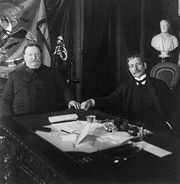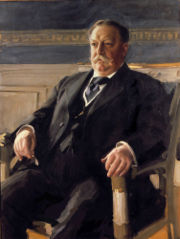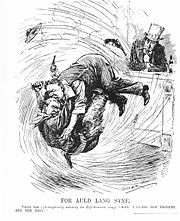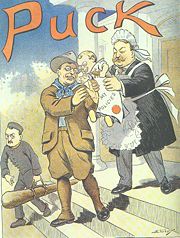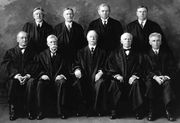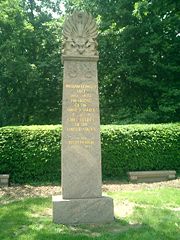William Howard Taft
2008/9 Schools Wikipedia Selection. Related subjects: USA Presidents
|
William Howard Taft
|
|
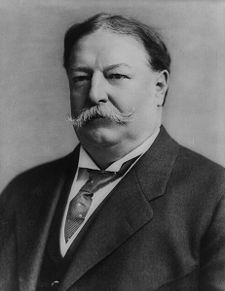 |
|
|
10th Chief Justice of the United States
|
|
| In office July 11, 1921 – February 3, 1930 |
|
| Nominated by | Warren G. Harding |
|---|---|
| Preceded by | Edward Douglass White |
| Succeeded by | Charles Evans Hughes |
|
|
|
| In office March 4, 1909 – March 4, 1913 |
|
| Vice President | James S. Sherman, (1909–1912) None (1912–1913) |
| Preceded by | Theodore Roosevelt |
| Succeeded by | Woodrow Wilson |
|
1st Provisional Governor of Cuba
|
|
| In office September 29, 1906 – October 13, 1906 |
|
| Preceded by | Tomás Estrada Palma (President of Cuba) |
| Succeeded by | Charles Magoon (U.S. Governor) |
|
42nd United States Secretary of War
|
|
| In office February 1, 1904 – June 30, 1908 |
|
| President | Theodore Roosevelt |
| Preceded by | Elihu Root |
| Succeeded by | Luke Edward Wright |
|
1st Civil Governor of the Philippines
|
|
| In office July 4, 1901 – December 23, 1903 |
|
| Preceded by | Arthur MacArthur, Jr. (U.S. Military Governor) |
| Succeeded by | Luke Edward Wright |
|
5th United States Solicitor General
|
|
| In office February 1890 – March, 1892 |
|
| President | Benjamin Harrison |
| Preceded by | Orlow W. Chapman |
| Succeeded by | Charles H. Aldrich |
|
|
|
| Born | September 15, 1857 Cincinnati, Ohio |
| Died | March 8, 1930 (aged 72) Washington, D.C. |
| Political party | Republican |
| Spouse | Helen Herron Taft |
| Alma mater | Yale University University of Cincinnati |
| Occupation | Lawyer, Jurist |
| Religion | Unitarian |
| Signature | |
William Howard Taft ( September 15, 1857 – March 8, 1930) was an American politician, the twenty-seventh President of the United States, the tenth Chief Justice of the United States, a leader of the progressive conservative wing of the Republican Party in the early 20th century, a pioneer in international arbitration and staunch advocate of world peace verging on pacifism, and scion of a leading political family, the Tafts, of Ohio.
Taft served as the Solicitor General of the United States, a federal judge, Governor-General of the Philippines, and Secretary of War before being nominated for President in the 1908 Republican National Convention with the backing of his predecessor and close friend Theodore Roosevelt.
His presidency was characterized by trust-busting, strengthening the Interstate Commerce Commission, expanding the civil service, establishing a better postal system, and promoting world peace. Roosevelt broke with Taft in 1911, charging Taft was too reactionary. Taft and the conservatives were alarmed at Roosevelt's attacks on the judiciary, and took control of the party machinery. Taft defeated Roosevelt for the Republican nomination in a bruising battle in 1912 that forced Roosevelt out of the GOP and left Taft's people in charge for decades. William Howard Taft remains the only U.S. President to finish third in a bid for reelection to a second consecutive term. During World War I he helped set national labor policy that reduced strikes and generated union support for the national cause. In 1921, he became Chief Justice. As President and Chief Justice he helped make the federal courts, especially the Supreme Court, much more powerful in shaping national policy. To date he is the only former president to serve on the Supreme Court.
Early life
Taft was born on September 15, 1857, in Cincinnati, Ohio, the third of five children. His mother, Louisa Torrey, was a graduate of Mount Holyoke College. His father, Alphonso Taft, came to Cincinnati in 1839 to open a law practice. Alphonso Taft was a prominent Republican and served as Secretary of War under President Ulysses S. Grant.
Taft was brought up in the Unitarian church and remained a faithful Unitarian his entire life (later in life he once remarked, "I do not believe in the divinity of Christ, and there are many other of the postulates of the orthodox creed to which I can not subscribe."). At age 18, he met his future wife, Helen Herron, in Cincinnati; she and Taft courted while he was away at college. He enjoyed spending time with his aunt, Meredith Johnson, who required wheelchair and crutches to get around.
The William Howard Taft National Historic Site is the Taft boyhood home. The house in which he was born has been restored to its original appearance. It includes four period rooms that reflect the family life during Taft's boyhood. The home also includes second floor exhibits highlighting Taft's life centre.
Education
In 1874, Taft attended Woodward High School. Like most of his family, he attended Yale College in New Haven, Connecticut. At Yale, he was a member of the Linonian Society, a literary and debate society; Skull and Bones, the secret society co-founded by his father in 1832; and the Beta chapter of the Psi Upsilon fraternity. Later in life he was also inducted into the Omicron-Omicron chapter of the secret society of Theta Nu Epsilon, after delivering the commencement address to the class of 1910 at Ohio Northern University. He was given the nickname "Big Lub" because of his size, but his college friends knew him by the nickname "Old Bill". Taft received jibes about his weight throughout his life: as governor of the Philippines, Taft once sent a telegram to Washington, D.C. that read, "Went on a horse ride today; feeling good;" Secretary of War Elihu Root replied, "How's the horse?" In 1878, Taft graduated from Yale, ranking second in his class out of 121. After college, he attended Cincinnati Law School, graduating with a Bachelor of Laws in 1880. While in law school, he worked on the area newspaper The Cincinnati Commercial.
Career
Legal career
After admission to the Ohio bar, Taft was appointed Assistant Prosecutor of Hamilton County, Ohio, based in Cincinnati. In 1882, he was appointed local Collector of Internal Revenue. Taft married his longtime sweetheart, Helen Herron, in Cincinnati in 1886. In 1887, he was appointed as a judge of the Ohio Superior Court. In 1890, President Benjamin Harrison appointed him Solicitor General of the United States. In 1892 Harrison appointed him to the newly created United States Court of Appeals for the Sixth Circuit, a post that he held until 1900. It was then that he met Theodore Roosevelt for the first time. In about 1893, Taft decided in favour of one or more patents for processing aluminium belonging to the Pittsburg Reduction Company, today known as Alcoa, who settled with the other party in 1903 and became for a short while the only aluminium producer in the U.S.
In addition to his judgeship, between 1896 and 1900 Taft also served as the first dean and a professor of constitutional law at the University of Cincinnati. Eventually, he became the chief judge of the Sixth Circuit. One of Taft's most famous opinions was in Addyston Pipe and Steel Company v. United States (1898).
Political career
In 1900, President William McKinley appointed Taft as the chairman of a commission to organize a civilian government in the Philippines, which had been ceded to the United States by Spain following the Spanish-American War and the 1898 Treaty of Paris. Although Taft initially had been opposed to the annexation of the islands and told McKinley that his real ambition was to become a justice of the Supreme Court of the United States, he reluctantly accepted the appointment when McKinley suggested that he would be "the better judge for this experience."
From 1901 to 1903, Taft served as the first civilian Governor-General of the Philippines, a position in which he was very popular among both Americans and Filipinos. In 1902, Taft visited Rome to negotiate with Pope Leo XIII for the purchase of lands in the Philippines owned by the Roman Catholic Church. Taft then persuaded Congress to appropriate $7,239,000 to purchase the lands, which he sold to Filipinos on easy terms. In 1903, President Roosevelt offered Taft the seat on the Supreme Court to which he had for so long aspired, but he reluctantly declined when native Filipino groups begged him to remain in Manila as Governor-General.
Secretary of War, 1904–1908
In 1904, Roosevelt appointed Taft as Secretary of War. Roosevelt made the basic policy decisions regarding military affairs, using Taft as a well-traveled spokesman who campaigned for Roosevelt's re-election in 1904. Taft met with the Emperor of Japan, who alerted him of the probability of war with Russia. In 1906, Roosevelt sent troops to restore order in Cuba during the revolt led by General Enrique Loynaz del Castillo, and Taft temporarily became the Civil Governor of Cuba, personally negotiating with General Castillo for a peaceful end to the revolt. In 1907, Secretary Taft helped supervise the beginning of construction on the Panama Canal. Taft repeatedly had told Roosevelt he wanted to be Chief Justice, not President (and not an associate justice), but there was no vacancy and Roosevelt had other plans. He gave Taft more responsibilities in addition to the Philippines and the Panama Canal. For a while, Taft was Acting Secretary of State. When Roosevelt was away, Taft in effect was the Acting President.
Presidential election of 1908
After serving for nearly two full terms, the popular Theodore Roosevelt refused to run in the election of 1908. Roosevelt certified Taft as a genuine "progressive", in 1908, pushing through the nomination of his Secretary of War for the presidency. At the age 51 and after a legal and political career of more than 20 years, Taft ran in an election for the first time. His opponent was William Jennings Bryan, who had ran for president twice in 1896 and 1900 against William McKinley. During the campaign Taft undercut Bryan's liberal support by accepting some of his reformist ideas and Roosevelt's progressive policies blurred the distinctions between the parties. Bryan on the other hand ran a vigorous campaign against the nation's business elite. But in the end, Taft won by a comfortable margin, giving Bryan his worst loss in three presidential campaigns.
Presidency, 1909–1913
Policies
Taft considered himself a "progressive" because of his deep belief in "The Law" as the scientific device that should be used by judges to solve society's problems. Taft proved a less adroit politician than Roosevelt and seemed to lack the energy and personal magnetism of his mentor, not to mention the publicity devices, the dedicated supporters, and the broad base of public support that made Roosevelt so formidable. When Roosevelt realized that lowering the tariff would risk severe tensions inside the Republican Party, pitting producers (manufacturers and farmers) against department stores and consumers, he stopped talking about the issue. Taft ignored the risks and tackled the tariff boldly, on the one hand encouraging reformers to fight for lower rates, then cutting deals with conservative leaders that kept overall rates high. The resulting Payne-Aldrich tariff of 1909 was too high for most reformers, but instead of blaming this on Senator Nelson Aldrich and big business, Taft took credit, calling it the best bill to come from the Republican Party. Again, he had managed to alienate all sides.
Unlike Roosevelt, Taft never attacked business or businessmen in his rhetoric. However, he was attentive to the law, so he launched 80 antitrust suits, including one against the country's largest corporation, U.S. Steel, for an acquisition that Roosevelt personally had approved. As a result, Taft lost the support of antitrust reformers (who disliked his conservative rhetoric), of big business (which disliked his actions), and of Roosevelt, who felt humiliated by his protégé. Progressives within the Republican party began agitating against Taft. Senator Robert LaFollette of Wisconsin created the National Progressive Republican League to replace Taft at the national level; his campaign crashed after a disastrous speech. Most of LaFollette's supporters went over to Roosevelt, leaving LaFollette embittered and alone. More trouble came when Taft fired Gifford Pinchot, a leading conservationist and close ally of Roosevelt. Pinchot alleged that Taft's Secretary of Interior Richard Ballinger was in league with big timber interests. Conservationists sided with Pinchot, and Taft alienated yet another vocal constituency.
Taft fought for the prosecution of trusts (eventually issuing 80 lawsuits), further strengthened the Interstate Commerce Commission, established a postal savings bank and a parcel post system, and expanded the civil service. He supported the 16th Amendment, which allowed for a federal income tax, and the 17th Amendment, mandating the direct election of senators by the people, replacing the previous system whereby they were selected by state legislatures.
Foreign policy
Taft actively pursued what he termed " dollar diplomacy" to further the economic development of less-developed nations of Latin America and Asia through American investment in their infrastructures. Throughout the early part of his presidency, Taft had difficulties with Nicaragua. When the United States shifted its interests to Panama for the purpose of building a canal, Nicaraguan President José Santos Zelaya negotiated with Germany and Japan in an unsuccessful effort to have a canal constructed in his country. The Zelaya administration had growing friction with the United States government, which started giving aid to his Conservative opponents in Nicaragua. In 1907, U.S. warships seized several of Nicaragua's seaports. In early December, United States Marines landed on Nicaragua's Caribbean Sea coast. On December 17, 1909, Zelaya resigned and left for exile in Mexico. The U.S.-sponsored conservative regime of Adolfo Díaz was installed in his place. Military invasions increased with marine landings in 1910 and 1912. The Marines stayed in Nicaragua through 1925.
One of Taft's main goals while President was to further the idea of world peace. Given his judicial sensibilities, he believed that international arbitration was the best means to effectuate the end of war on Earth. As such, he championed several reciprocity and arbitration treaties. In 1910, he convinced congressional Democrats to support a reciprocity treaty with Canada, but the Liberal Canadian government of Wilfrid Laurier that negotiated the treaty was turned out of office in 1911 and the treaty collapsed. In 1910 and 1911, however, he secured the ratification of arbitration treaties that he had successfully negotiated with Britain and France and thereafter was known as one of the foremost advocates of world peace and arbitration.
16th Amendment
To solve an impasse during the 1909 tariff debate, Taft proposed income taxes for corporations and a constitutional amendment to remove the apportionment requirement for taxes on incomes from property (taxes on dividends, interest and rents), on June 16, 1909. His proposed tax on corporate net income was 1% on net profits over $5,000. It was designated an excise on the privilege of doing business as a corporation whose stockholders enjoyed the privilege of limited liability, and not a tax on incomes as such. In 1911, the Supreme Court, in Flint v. Stone Tracy Co., upheld the tax. Receipts grew from $21 million in the fiscal year 1910 to $34.8 million in 1912.
In July, 1909, a proposed amendment to remove the apportionment requirement was passed unanimously in the Senate and by a vote of 318 to 14 in the House. It was quickly ratified by the states, and in February 3, 1913, it became a part of the Constitution as the Sixteenth Amendment, as Taft was leaving office.
Party schism
Despite his obvious achievements, progressives decried Taft's acceptance of the Payne-Aldrich Tariff Act, which lowered the tariff on the farm products of the western states, whose citizens desired lower rates on Eastern factory products. Taft opposed the entry of the state of Arizona into the Union because of its judicial features. Progressives grumbled that he worked too closely with conservative Senator Nelson W. Aldrich and Speaker of the House Joseph G. Cannon. By 1910, Taft's party was deeply divided between progressives and conservatives.
On his return from Europe, Roosevelt broke with Taft in one of the most dramatic political feuds of the 20th century. To the surprise of observers who thought Roosevelt had unstoppable momentum, Taft outmaneuvered Roosevelt and LaFollette, seized control of the GOP, and forced both out of the party. The main issue in 1911–12 was independence of the judiciary, which Roosevelt denounced. Most lawyers in the GOP supported Taft, including many of Roosevelt's key supporters like Elihu Root, Henry Stimson, and Roosevelt's own son-in-law, Nicholas Longworth. In lining up delegates for the 1912 nomination, Taft outmaneuvered Roosevelt, who had started much too late, and kept control of the Republican party. 1912 was the first year that some delegates were determined through primary elections. Primary elections were seen as a way to take power away from party bosses and put it in the hands of the people. Out of the 14 Republican primaries held, Roosevelt won 9, and Taft only won 3. Robert Lafollette won the other 2. Nevertheless, Taft had the delegates and won the nomination at the Republican nominating convention in Chicago.
Instead, Roosevelt was forced to create the Progressive Party (or "Bull Moose") ticket, splitting the Republican vote in the 1912 election. Woodrow Wilson, the Democrat, was elected, although many historians argue that Wilson would have won anyway, because the Republican factions would not support each other. Taft won the mere eight electoral votes of Utah and Vermont, making it the single worst defeat in American history for an incumbent President seeking re-election. He achieved what he felt were his main goals as President, however: keeping permanent control of the party and making the courts sacrosanct. It also should be noted that while the strife during the election of 1912 devastated the once very close friendship between Taft and Theodore Roosevelt, the two eventually did reconcile not long before Roosevelt's death in 1919.
Administration and cabinet
| OFFICE | NAME | TERM |
|---|---|---|
| President | William Howard Taft | 1909–1913 |
| Vice President | James S. Sherman | 1909–1912 |
| None | 1912–1913 | |
| Secretary of State | Philander C. Knox | 1909–1913 |
| Secretary of the Treasury | Franklin MacVeagh | 1909–1913 |
| Secretary of War | Jacob M. Dickinson | 1909–1911 |
| Henry L. Stimson | 1911–1913 | |
| Attorney General | George W. Wickersham | 1909–1913 |
| Postmaster General | Frank H. Hitchcock | 1909–1913 |
| Secretary of the Navy | George von L. Meyer | 1909–1913 |
| Secretary of the Interior | Richard A. Ballinger | 1909–1911 |
| Walter L. Fisher | 1911–1913 | |
| Secretary of Agriculture | James Wilson | 1909–1913 |
| Secretary of Commerce & Labor | Charles Nagel | 1909–1913 |
Supreme Court appointments
During his presidency, Taft appointed the following Justices to the Supreme Court of the United States:
- Horace Harmon Lurton — 1910
- Lurton had served on the United States Court of Appeals for the Sixth Circuit with Taft, and Taft's attorney general said that at 66 he was too old to become a Supreme Court justice, but Taft had always admired Lurton. According to the Complete Book of U.S. Presidents (2001 edition), Taft later said that "the chief pleasure of my administration" was the appointment of Lurton.
- Charles Evans Hughes — 1910
- Even though Hughes resigned in 1916 to run in the presidential election that year, he became Taft's successor as Chief Justice.
- Edward Douglass White — Chief Justice — 1910
- Already on the Court as an associate justice since 1894, White was the first Chief Justice to be elevated from an associate justiceship. Taft succeeded White as Chief Justice in 1921.
- Willis Van Devanter — 1911
- Joseph Rucker Lamar — 1911
- Mahlon Pitney — 1912
Taft's six appointments to the Court rank (in number) third only to those of George Washington (who appointed the entire Court as the first President) and Franklin D. Roosevelt (who was president for twelve years); as well, his appointment of five new justices ties the number appointed by Andrew Jackson and Abraham Lincoln. Four of Taft's appointees were relatively young at ages 48, 51, 53 and 54.
The appointments of Edward Douglass White and Charles Evans Hughes also are notable because Taft essentially appointed both his predecessor and successor Chief Justices, respectively. Hughes initially was appointed an Associate Justice, but later resigned to run for the Republican Party's presidential candidate in the 1916 election, which he would lose. President Herbert Hoover renominated Hughes to the Supreme Court as Chief Justice following Taft's retirement.
States admitted to the Union
- New Mexico: January 6, 1912
- Arizona: February 14, 1912. Taft had opposed the admission of Arizona owing to what he viewed as defects in its judicial system.
Post-presidency
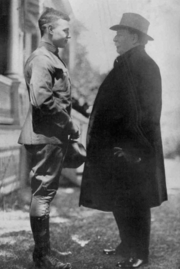
Upon leaving the White House in 1913, Taft was appointed the Chancellor Kent Professor of Law and Legal History at Yale Law School. Upon his appointment, the Yale Chapter of the Acacia Fraternity made him an honorary member. At the same time Taft was elected president of the American Bar Association. He spent much of his time writing newspaper articles and books, most notably his series on American legal philosophy. He was a vigorous opponent of prohibition in the United States, predicting the undesirable situation that the Eighteenth Amendment and prohibition in general would create. He also continued to advocate world peace through international arbitration, urging nations to enter into arbitration treaties with each other and promoting the idea of a League of Nations even before the First World War began.
When World War I did break out in Europe in 1914, however, Taft founded the League to Enforce Peace. He was co-chair of the powerful National War Labor Board between 1917 and 1918. Although he continually advocated peace, he strongly favored conscription once the United States entered the conflict, pleading publicly that the United States not fight a "finicky" war. He feared the war would be long, but was for fighting it out to a finish, given what he viewed as "Germany's brutality."
Chief Justice, 1921-1930
Nomination
In 1921, when Chief Justice Edward Douglass White died, President Warren G. Harding nominated Taft to take his place, thereby fulfilling Taft's lifelong ambition to become Chief Justice of the United States. Very little opposition existed to the nomination, and the Senate approved him 60-4 in a secret session, but the roll call of the vote has never been made public. He readily took up the position, serving until 1930. As such, he became the only President to serve as Chief Justice, and thus is also the only former President to swear in subsequent Presidents, giving the oath of office to both Calvin Coolidge (in 1925) and Herbert Hoover (in 1929). He remains the only person to have led both the Executive and Judicial branches of the United States government. He considered his time as Chief Justice to be the highest point of his career: he allegedly once remarked, "I don't remember that I ever was President."
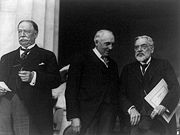
Achievements
In 1922, Taft traveled to England to study the procedural structure of the English courts and learn how they disposed of such a large number of cases in such an expeditious manner. During the trip, King George V and Queen Mary received Taft and his wife as state visitors. With what he had learned in England, Taft advocated passage of the Judiciary Act of 1925 (often called the "Judges Bill"), which shifted the Supreme Court's appellate jurisdiction to be exercisable principally on review by writ of certiorari, thereby empowering the Supreme Court to give preference to cases of national importance and allowing the Court to work more efficiently. In addition to giving the Court more control over its docket, the new legislation (and the Judicial Conference that Taft organized) gave the Supreme Court and the Chief Justice general supervisory power over the scattered and disorganized federal courts, bringing the District of Columbia and the territories within the federal system, uniting the courts for the first time as an independent third branch of government (contrary to the British model) under the administrative supervision of the Chief Justice of the United States. Taft was also the first Justice to employ two full-time law clerks.
In 1929, Taft successfully argued for the construction of the Supreme Court Building, reasoning that the court needed to distance itself from Congress as a separate branch of government. Until then, the Court had heard cases in the old Senate Chamber of the Capitol; the justices had no chambers and their conferences were held in a room in the basement. Taft, however, did not live to see the building's completion in 1935.
Opinions
While Chief Justice, Taft wrote the opinion for the Court in 256 cases out of the Court's ever-growing caseload. His philosophy of constitutional interpretation was essentially historical contextualism. Some of his more notable opinions include:
- Balzac v. Porto Rico, (opinion for the Court)
- Ruling that the Fourteenth Amendment did not apply the criminal provisions of the Bill of Rights to overseas territories. This was one of the more famous of the " Insular Cases."
- Bailey v. Drexel Furniture Co., (opinion for the Court)
- Holding the 1919 Child Labor Tax Law unconstitutional.
- Hill v. Wallace, (opinion for the Court)
- Holding the Future Trading Act an unconstitutional use of Congress's taxing power
- Adkins v. Children's Hospital, (dissenting opinion)
- Disapproving of the Court upholding Lochner v. New York.
- Board of Trade of City of Chicago v. Olsen, (opinion for the Court)
- Upholding the constitutionality of the Grain Futures Act under the Commerce Clause
- Ex Parte Grossman, (opinion for the Court)
- Holding that the President's pardon power extends to pardoning people held for criminal contempt; as of 2008, while the Supreme Court rules provide issuing writs of habeas corpus within the Court's original jurisdiction, Taft's opinion in Grossman was the last time the Court did so
- Carroll v. United States, (opinion for the Court)
- Holding that police searches of automobiles without a warrant do not violate the Fourth Amendment when the police have probable cause to believe contraband would be found in the automobile
- Myers v. United States, (opinion for the Court)
- Ruling that the President of the United States had the power unilaterally to dismiss executive appointees who had been confirmed by the Senate.
- Gong Lum v. Rice, (opinion for the Court)
- Ruling that the Fourteenth Amendment did not prohibit Mississippi's prevention of Asian children attending white schools in the midst of racial segregation.
- Olmstead v. United States, (opinion for the Court)
- Ruling that the judicial practice of excluding evidence obtained without a warrant was based on the Fourth Amendment's proscription on unreasonable search and seizure but did not apply to wiretaps.
- Wisconsin v. Illinois, (opinion for the Court)
- Holding that the equitable power of the United States can be used to impose positive action on the states in a situation in which nonaction would result in damage to the interests of other states.
- Old Colony Trust Co. v. Commissioner, (opinion for the Court)
- Holding that where a third party pays the income tax due to an individual, the amount of tax paid constitutes additional income to the taxpayer.
Medical condition
Evidence from eyewitnesses and from Taft himself strongly suggests that he had severe obstructive sleep apnea during his presidency, resulting from his obesity. Within a year of leaving the presidency, Taft lost approximately 80 pounds (32 kg). His somnolence resolved and, less obviously, his systolic blood pressure dropped 40–50 mmHg (from 210 mmHg). Undoubtedly, this weight loss extended his life. Beginning in 1920, Taft used a cane; his was a gift from Professor of Geology W.S. Foster, made of 250,000-year-old wood.
Death and legacy
Taft retired as Chief Justice on February 3, 1930, because of ill health. He was succeeded by Charles Evans Hughes, whom he had appointed to the Court while President. Taft died after succumbing to illness on March 8, 1930. Three days later, on March 11, he became the first president to be buried at Arlington National Cemetery. His grave marker was sculpted by James Earle Fraser out of Stony Creek granite.. William Howard Taft and John Fitzgerald Kennedy are the only Presidents of the United States buried in Arlington National Cemetery.
A third generation of the Taft family entered the national political stage in 1938, with the election of the former President's oldest son Robert A. Taft I to the United States Senate, representing Ohio; he continued in office as a senator until his death in 1953. His other son, Charles Phelps Taft II, served as mayor of Cincinnati, Ohio, from 1955 to 1957. Two more generations of the Taft family later entered politics. The President's grandson, Robert Taft Jr., served a term as a Senator from Ohio from 1971 to 1977; the President's great-grandson, Robert A. Taft II, served as the governor of Ohio from 1999 to 2007. William Howard Taft III was U.S. ambassador to Ireland from 1953 to 1957. William Howard Taft IV, currently in private law practice, was general counsel in the former Department of Health, Education, and Welfare in the 1970s, Deputy Secretary of Defense under Casper Weinberger and Frank Carlucci in the 1980s, and acted as Secretary of Defense during the vacancy of January–March 1989. In addition, he was a high-level official in the United States Department of State from 2000 to 2006.
Taft's enduring legacy has included many things being named after him. These include the courthouse of the Ohio Court of Appeals for the First District in Cincinnati, Ohio, streets in Cincinnati, Ohio, and Manila, Philippines, a law school in Santa Ana, California, and high schools in San Antonio, Texas, Woodland Hills, California, Chicago, Illinois, and the Bronx, New York. After a fire burned much of the town of Moron, California during the 1920s, it was renamed Taft, in his honour.
According to legend (though probably apocryphal), the traditional 7th inning stretch at baseball games is owed to Taft. The president was watching a game and, in the 7th inning, got up to stretch. The crowd, out of respect for the president, also rose to their feet. Since then, people have stretched during the 7th inning.
